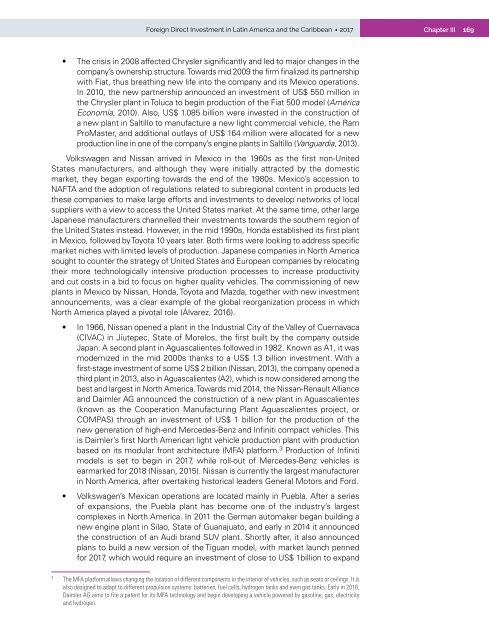Foreign Direct Investment in Latin America and the Caribbean 2017
This publication sets out and analyses the main foreign direct investment (FDI) trends in the countries of Latin America and the Caribbean. The 2017 edition shows that the region is at a difficult juncture. FDI inflows declined by 7.9% in 2016, to US$ 167.043 billion, representing a cumulative fall of 17.0% since the peak in 2011. The fall in commodity prices continues to affect investments in natural resources, sluggish economic growth in several countries has slowed the flow of market-seeking capital, and the global backdrop of technological sophistication and expansion of the digital economy has concentrated transnational investments in developed economies.
This publication sets out and analyses the main foreign direct investment (FDI) trends in the countries of Latin America and the Caribbean. The 2017 edition shows that the region is at a difficult juncture. FDI inflows declined by 7.9% in 2016, to US$ 167.043 billion, representing a cumulative fall of 17.0% since the peak in 2011. The fall in commodity prices continues to affect investments in natural resources, sluggish economic growth in several countries has slowed the flow of market-seeking capital, and the global backdrop of technological sophistication and expansion of the digital economy has concentrated transnational investments in developed economies.
You also want an ePaper? Increase the reach of your titles
YUMPU automatically turns print PDFs into web optimized ePapers that Google loves.
<strong>Foreign</strong> <strong>Direct</strong> <strong>Investment</strong> <strong>in</strong> Lat<strong>in</strong> <strong>America</strong> <strong>and</strong> <strong>the</strong> <strong>Caribbean</strong> • <strong>2017</strong><br />
Chapter III<br />
169<br />
• The crisis <strong>in</strong> 2008 affected Chrysler significantly <strong>and</strong> led to major changes <strong>in</strong> <strong>the</strong><br />
company’s ownership structure. Towards mid 2009 <strong>the</strong> firm f<strong>in</strong>alized its partnership<br />
with Fiat, thus breath<strong>in</strong>g new life <strong>in</strong>to <strong>the</strong> company <strong>and</strong> its Mexico operations.<br />
In 2010, <strong>the</strong> new partnership announced an <strong>in</strong>vestment of US$ 550 million <strong>in</strong><br />
<strong>the</strong> Chrysler plant <strong>in</strong> Toluca to beg<strong>in</strong> production of <strong>the</strong> Fiat 500 model (América<br />
Economía, 2010). Also, US$ 1.085 billion were <strong>in</strong>vested <strong>in</strong> <strong>the</strong> construction of<br />
a new plant <strong>in</strong> Saltillo to manufacture a new light commercial vehicle, <strong>the</strong> Ram<br />
ProMaster, <strong>and</strong> additional outlays of US$ 164 million were allocated for a new<br />
production l<strong>in</strong>e <strong>in</strong> one of <strong>the</strong> company’s eng<strong>in</strong>e plants <strong>in</strong> Saltillo (Vanguardia, 2013).<br />
Volkswagen <strong>and</strong> Nissan arrived <strong>in</strong> Mexico <strong>in</strong> <strong>the</strong> 1960s as <strong>the</strong> first non-United<br />
States manufacturers, <strong>and</strong> although <strong>the</strong>y were <strong>in</strong>itially attracted by <strong>the</strong> domestic<br />
market, <strong>the</strong>y began export<strong>in</strong>g towards <strong>the</strong> end of <strong>the</strong> 1980s. Mexico’s accession to<br />
NAFTA <strong>and</strong> <strong>the</strong> adoption of regulations related to subregional content <strong>in</strong> products led<br />
<strong>the</strong>se companies to make large efforts <strong>and</strong> <strong>in</strong>vestments to develop networks of local<br />
suppliers with a view to access <strong>the</strong> United States market. At <strong>the</strong> same time, o<strong>the</strong>r large<br />
Japanese manufacturers channelled <strong>the</strong>ir <strong>in</strong>vestments towards <strong>the</strong> sou<strong>the</strong>rn region of<br />
<strong>the</strong> United States <strong>in</strong>stead. However, <strong>in</strong> <strong>the</strong> mid 1990s, Honda established its first plant<br />
<strong>in</strong> Mexico, followed by Toyota 10 years later. Both firms were look<strong>in</strong>g to address specific<br />
market niches with limited levels of production. Japanese companies <strong>in</strong> North <strong>America</strong><br />
sought to counter <strong>the</strong> strategy of United States <strong>and</strong> European companies by relocat<strong>in</strong>g<br />
<strong>the</strong>ir more technologically <strong>in</strong>tensive production processes to <strong>in</strong>crease productivity<br />
<strong>and</strong> cut costs <strong>in</strong> a bid to focus on higher quality vehicles. The commission<strong>in</strong>g of new<br />
plants <strong>in</strong> Mexico by Nissan, Honda, Toyota <strong>and</strong> Mazda, toge<strong>the</strong>r with new <strong>in</strong>vestment<br />
announcements, was a clear example of <strong>the</strong> global reorganization process <strong>in</strong> which<br />
North <strong>America</strong> played a pivotal role (Álvarez, 2016).<br />
• In 1966, Nissan opened a plant <strong>in</strong> <strong>the</strong> Industrial City of <strong>the</strong> Valley of Cuernavaca<br />
(CIVAC) <strong>in</strong> Jiutepec, State of Morelos, <strong>the</strong> first built by <strong>the</strong> company outside<br />
Japan. A second plant <strong>in</strong> Aguascalientes followed <strong>in</strong> 1982. Known as A1, it was<br />
modernized <strong>in</strong> <strong>the</strong> mid 2000s thanks to a US$ 1.3 billion <strong>in</strong>vestment. With a<br />
first-stage <strong>in</strong>vestment of some US$ 2 billion (Nissan, 2013), <strong>the</strong> company opened a<br />
third plant <strong>in</strong> 2013, also <strong>in</strong> Aguascalientes (A2), which is now considered among <strong>the</strong><br />
best <strong>and</strong> largest <strong>in</strong> North <strong>America</strong>. Towards mid 2014, <strong>the</strong> Nissan-Renault Alliance<br />
<strong>and</strong> Daimler AG announced <strong>the</strong> construction of a new plant <strong>in</strong> Aguascalientes<br />
(known as <strong>the</strong> Cooperation Manufactur<strong>in</strong>g Plant Aguascalientes project, or<br />
COMPAS) through an <strong>in</strong>vestment of US$ 1 billion for <strong>the</strong> production of <strong>the</strong><br />
new generation of high-end Mercedes-Benz <strong>and</strong> Inf<strong>in</strong>iti compact vehicles. This<br />
is Daimler’s first North <strong>America</strong>n light vehicle production plant with production<br />
based on its modular front architecture (MFA) platform. 3 Production of Inf<strong>in</strong>iti<br />
models is set to beg<strong>in</strong> <strong>in</strong> <strong>2017</strong>, while roll-out of Mercedes-Benz vehicles is<br />
earmarked for 2018 (Nissan, 2015). Nissan is currently <strong>the</strong> largest manufacturer<br />
<strong>in</strong> North <strong>America</strong>, after overtak<strong>in</strong>g historical leaders General Motors <strong>and</strong> Ford.<br />
• Volkswagen’s Mexican operations are located ma<strong>in</strong>ly <strong>in</strong> Puebla. After a series<br />
of expansions, <strong>the</strong> Puebla plant has become one of <strong>the</strong> <strong>in</strong>dustry’s largest<br />
complexes <strong>in</strong> North <strong>America</strong>. In 2011 <strong>the</strong> German automaker began build<strong>in</strong>g a<br />
new eng<strong>in</strong>e plant <strong>in</strong> Silao, State of Guanajuato, <strong>and</strong> early <strong>in</strong> 2014 it announced<br />
<strong>the</strong> construction of an Audi br<strong>and</strong> SUV plant. Shortly after, it also announced<br />
plans to build a new version of <strong>the</strong> Tiguan model, with market launch penned<br />
for <strong>2017</strong>, which would require an <strong>in</strong>vestment of close to US$ 1billion to exp<strong>and</strong><br />
3<br />
The MFA platform allows chang<strong>in</strong>g <strong>the</strong> location of different components <strong>in</strong> <strong>the</strong> <strong>in</strong>terior of vehicles, such as seats or ceil<strong>in</strong>gs. It is<br />
also designed to adapt to different propulsion systems: batteries, fuel cells, hydrogen tanks <strong>and</strong> even gas tanks. Early <strong>in</strong> 2018,<br />
Daimler AG aims to file a patent for its MFA technology <strong>and</strong> beg<strong>in</strong> develop<strong>in</strong>g a vehicle powered by gasol<strong>in</strong>e, gas, electricity<br />
<strong>and</strong> hydrogen.


















